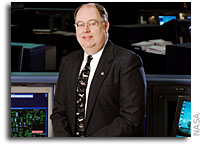Wayne Hale’s NASA Blog: Great Expectations

First of all, thanks to all who wondered how I have been doing. It has been a very busy month and I’m afraid that blogging fell off my “to do” list. The outlook for summer is also extremely busy but I will try to update frequently as I have the time!
Yesterday we rightly spent the day remembering those who paid the ultimate sacrifice for our country and for freedom. It is, as Lincoln said, altogether fitting and proper that we should do this. For our sake, not for theirs, to rededicate our lives, not to consecrate what they have done.
But yesterday, May 25, was another anniversary; in 1961 the young President of the United States boldly proposed that this nation should send a man to the moon and return him safely to the earth before the decade was out. That is a good thing to commemorate, too. Our nation achieved that goal and we still bask in the reflected glory of that achievement.
It is hard to remember, but within the life of those older than . . . 48 . . . that to “aim for the moon” was a code phrase for setting out to do the impossible. A quixotic task. Something that no serious person would attempt. Something guaranteed to fail because it was so patently impossible. Foolish, foolhardy, not worth attempting.
The nation just witnessed the repair and refurbishment of the Hubble Space Telescope. Moments of high drama, all carried out by human beings. A repetition of similar missions which transformed NASA’s biggest flop into the most productive scientific instrument of our time. In retrospect it looked so, so very easy; and so, so very risk free. It was neither. Nor was it cheap.
As always there are a few critics out there that wish us to believe that such a mission was a waste of time and money, foolishness beyond description, risk undertaken for no good reason. They point out that if we were to take the money and resources spent on the Hubble servicing missions over the years we could have built a fleet of Hubble space telescopes.
Well, of course they are right. But they are also wrong. As Oscar Wilde once remarked, they know the price of everything and the value of nothing.
Because the cost is not just dollars and cents. It is in the will and achievement of the nation. In 1990 the Hubble looked like the biggest failure in the history of space exploration. Coupled with the recent loss of Challenger and the grounding of the shuttle fleet for elusive hydrogen leaks, the agency was on the brink of being disbanded. Proposals to send people beyond low earth orbit were scuttled. The national mood was depressed. Dollars and cents aside, no one would suggest that NASA build another telescope, much less a fleet of them.
What a difference we see now. Hubble, like its namesake, has revolutionized cosmology. We understand our place in the cosmos in a much more profound way that we did before. It is hard to even understand how we could have been so limited before.
In 1905, a Swiss patent office clerk by the name of Albert Einstein had what has been called the “anno mirabilis” — year of marvels — when he published five papers that changed the world. Interestingly, the Nobel committee rewarded him with their prize in Physics for his paper on the photo-electric effect even though many think that the award would have been for his paper on relativity or one of the other subjects. The photo-electric effect is such a mundane topic in comparison. Yet, this is the basis for modern digital semiconductor electronics. Computers, cell phones, GPS receivers, digital television, and much more rely on what Einstein described so brilliantly in 1905. An nobody in 1905 could predict any of these devices. In fact, the US Commissioner of Patents stated very shortly before 1905 that everything which could be invented had already been invented. He proposed shutting down the US Patent Office for lack of future work.
In one of those landmark papers, Albert Einstein introduced a term called “the cosmological constant”. He later felt that was his biggest mistake. In recent years, the Hubble Space Telescope collected information that indicates Einstein’s cosmological constant may have been one of his greatest predictions. There is an unknown process at work in the universe that is very poorly understood. Cosmologists call it “dark energy” and do not understand it. But its observed properties seem to fit closely with the ‘cosmological constant’.
If the HST had been labeled a failure in 1990 and never touched by the gloved hands of astronauts, it is unlikely – in the extreme – that future space telescopes would have been funded. After all, NASA was a flop, right? The accelerating expansion of the universe would have gone undiscovered for an untold period of time. The cosmological constant would still be regarded as Einstein’s biggest mistake. And we would not be on the trail of uncovering the characteristics of enigmatic “dark energy”.
So, in a hundred years from now, how will we solve the energy problem? Obviously all the inventions that can be invented already have been! And certainly we understand the universe perfectly well! And of course a whole fleet of Hubble Space Telescopes would have been built even if the first one was flawed!
Not.
The value of the human touch far surpasses the mere price of the journey.








